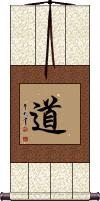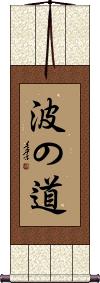Many custom options...
And formats...

Channel in Chinese / Japanese...
Buy a Channel calligraphy wall scroll here!
Personalize your custom “Channel” project by clicking the button next to your favorite “Channel” title below...
Daoism / Taoism
Literally: The Way or Road
道 is the character “dao” which is sometimes written as “tao” but pronounced like “dow” in Mandarin.
道 is the base of what is known as “Taoism.” If you translate this literally, it can mean “the way” or “the path.”
Dao is believed to be that which flows through all things and keeps them in balance. It incorporates the ideas of yin and yang (e.g. there would be no love without hate, no light without dark, no male without female.)
The beginning of Taoism can be traced to a mystical man named
Lao Zi (604-531 BC), who followed, and added to the teachings of Confucius.
More about Taoism / Daoism here.
Note that this is pronounced “dou” and sometimes “michi” when written alone in Japanese but pronounced “do” in word compounds such as Karate-do and Bushido. It's also “do” in Korean.
Alternate translations and meanings: road, way, path; truth, principle province.
Important Japanese note: In Japanese, this will generally be read with the road, way, or path meaning. Taoism is not as popular or well-known in Japan so Daoist/Taoist philosophy is not the first thing a Japanese person will think of when they read this character.
See our Taoism Page
The Way of the Wave
波の道 is the simple way to write “The Way of the Wave” in Japanese.
I added this at the request of several customers. 波の道 is not a very common Japanese phrase.
波 = Wave
の = Of
道 = Way
The word order is the opposite of English. Most Japanese phrases that end in “の道” are translated to English as “The Way of...”
Technically, you could write “波道” as a shorter version of “The Way of the Wave.” However, without context, 波道 can mean channel or suggest a path to redirect ocean flow.
Animal Kingdom
動物王國 is literally what it says.
There is even a TV show in China that is similar to Wild Kingdom or what you would currently see on the Discovery Channel that has this same title.
For your information: In the Chinese way of thinking, the Tiger is the king of the animal kingdom (lions are not native to China, so the tiger took the role that we have given to the lion in our western way of thinking).
The modern Japanese version has a slight variation on the last character (国 instead of 國). Let me know if you want the modern Japanese version (國 would be considered the old or traditional version).
These search terms might be related to Channel:
4. Right Action / Perfect Conduct
All Tenets of the Noble Eightfold Path
Buddha Way
Bushido / the Way of the Samurai
Control of Power
Drain the Pond to Get All the Fish
Filial Piety / Filial Conduct
Four Noble Truths: Path Leading Away From Suffering
Good Conduct
Guide / Help / Cooperate
I Control My Own Destiny
I Walk My Own Path
Kendo / the Way of the Sword
Kensho Jobutsu - Enlightenment - Path to Buddha
Love Will Find a Way
Milky Way Galaxy
Move on / Change Way of Thinking
Noble Eightfold Path
Self-Control
Self-Restraint / Self-Control
Speed Control
Tang Soo Do / Tang Hand Way
The Foundation of Good Conduct
The Great Path Has No Gate
The Middle Way
The Noble Eightfold Path
The Old Way / Old School
The Way of Five Pecks of Rice
The Way of Tea
The Way of the Dragon
The Way of the Wave
There is Always a Way Out
There is One Single Thread Binding My Way Together
Walk in the Way
Walking 100 Miles: Stopping at 90 Miles, is the Same as Stopping Half-Way
Warrior’s Path
Way of Life / Art of Life
Where There is a Will, There is a Way
Where There’s a Will There’s a Way
Will-Power / Self-Control
Zendo / the Zen Way
Not the results for channel that you were looking for?
Below are some entries from our dictionary that may match your channel search...
| Characters If shown, 2nd row is Simp. Chinese |
Pronunciation Romanization |
Simple Dictionary Definition |
剅 see styles |
lóu lou2 lou |
(dialect) an opening at the bottom of a dike for letting water in or out; small channel across a river embankment; (used in place names); Taiwan pr. [dou1] |
槽 see styles |
cáo cao2 ts`ao tsao sou / so そう |
trough; manger; groove; channel; (Tw) (computing) hard drive (See 琵琶) body (of a biwa) A trough, manger, channel. |
漕 see styles |
cáo cao2 ts`ao tsao sō |
to transport (esp. grain) by water; (literary) watercourse; canal A channel, canal; transport, especially by the 漕河 Grand Canal. |
澪 see styles |
rei / re れい |
(1) waterway; channel; (2) wake (of a ship); (female given name) Rei |
經 经 see styles |
jīng jing1 ching tsune つね |
classics; sacred book; scripture; to pass through; to undergo; to bear; to endure; warp (textile); longitude; menstruation; channel (TCM); abbr. for economics 經濟|经济[jing1 ji4] (female given name) Tsune A warp, that which runs lengthwise; to pass through or by, past; to manage, regulate; laws, canons, classics. Skt. sūtras; threads, threaded together, classical works. Also called 契經 and 經本. The sūtras in the Tripiṭaka are the sermons attributed to the Buddha; the other two divisions are 律 the Vinaya, and 論 the śāstras, or Abhidharma; cf. 三藏. Every sūtra begins with the words 如是我聞 'Thus did I hear', indicating that it contains the words of Śākyamuni. |
スジ see styles |
suji スジ |
(1) muscle; tendon; sinew; (2) vein; artery; (3) fiber; fibre; string; (4) line; stripe; streak; (5) reason; logic; (6) plot; storyline; (7) lineage; descent; (8) school (e.g. of scholarship or arts); (9) aptitude; talent; (10) source (of information, etc.); circle; channel; (11) well-informed person (in a transaction); (12) logical move (in go, shogi, etc.); (13) (shogi) ninth vertical line; (14) seam on a helmet; (15) (abbreviation) gristly fish paste (made of muscle, tendons, skin, etc.); (16) (archaism) social position; status; (n-suf,n,adj-no) (17) on (a river, road, etc.); along; (suf,ctr) (18) counter for long thin things; counter for roads or blocks when giving directions; (19) (archaism) (Edo period) counter for hundreds of mon (obsolete unit of currency); (given name) Suji |
他局 see styles |
takyoku たきょく |
(1) another broadcaster; another station; another channel; (2) another office; another bureau; another department |
信道 see styles |
xìn dào xin4 dao4 hsin tao nobumichi のぶみち |
(telecommunications) channel; (in Confucian texts) to believe in the principles of wisdom and follow them (surname) Nobumichi |
同局 see styles |
doukyoku / dokyoku どうきょく |
(1) the said bureau (office, department, broadcasting station, channel, etc.); (2) same bureau (office, department, broadcasting station, channel, etc.) |
堀切 see styles |
horizetsu ほりぜつ |
(archaism) man-made water channel (e.g. round a castle); artificial trench; moat; (surname) Horizetsu |
導入 导入 see styles |
dǎo rù dao3 ru4 tao ju dounyuu / donyu どうにゅう |
to introduce into; to channel; to lead; to guide into; to import (data) (noun, transitive verb) (1) introduction; bringing in; installation; setting up; importation; (2) introduction (to a story, lecture, etc.); introductory part |
引水 see styles |
yǐn shuǐ yin3 shui3 yin shui hikimizu ひきみず |
to pilot a ship; to channel water; to draw water (for irrigation) (surname) Hikimizu |
引河 see styles |
yǐn hé yin3 he2 yin ho |
irrigation channel |
径路 see styles |
keiro / kero けいろ |
(1) course; route; path; channel; (2) process; means |
明渠 see styles |
míng qú ming2 qu2 ming ch`ü ming chü meikyo / mekyo めいきょ |
(open, uncovered) water channel; canal (See 暗渠) open ditch |
明溝 明沟 see styles |
míng gōu ming2 gou1 ming kou |
open drainage channel; ditch |
暗渠 see styles |
àn qú an4 qu2 an ch`ü an chü ankyo あんきょ |
underground water channel; covered ditch; culvert subterranean drain; culvert; conduit |
暗溝 暗沟 see styles |
àn gōu an4 gou1 an kou ankou / anko あんこう |
sewer; underground drainage channel (See 暗渠・あんきょ) subterranean drain; culvert; conduit |
歸經 归经 see styles |
guī jīng gui1 jing1 kuei ching |
channel tropism (TCM) |
水尾 see styles |
mizuo みづお |
(1) waterway; channel; (2) wake (of a ship); (surname) Mizuo |
水路 see styles |
shuǐ lù shui3 lu4 shui lu suiro すいろ |
waterway (1) waterway; canal; channel; watercourse; aqueduct; (2) swimming pool lane; (surname) Mizumichi |
水道 see styles |
shuǐ dào shui3 dao4 shui tao suidou / suido すいどう |
watercourse (river, canal, drain etc); water route; lane (in a swimming pool) (1) water supply; water service; waterworks; tap water; (2) channel; strait; (3) water course; waterway; (surname) Mizumichi |
河槽 see styles |
hé cáo he2 cao2 ho ts`ao ho tsao |
river bed; channel |
河道 see styles |
hé dào he2 dao4 ho tao kadou / kado かどう |
river course; river channel river channel; floodway; (surname) Kōdō |
流路 see styles |
ryuuro / ryuro りゅうろ |
channel; duct; passage; watercourse; flow channel |
海峡 see styles |
kaikyou / kaikyo かいきょう |
channel (e.g. between two land masses); strait; (surname) Kaikyō |
海峽 海峡 see styles |
hǎi xiá hai3 xia2 hai hsia |
strait; channel See: 海峡 |
海門 海门 see styles |
hǎi mén hai3 men2 hai men kaimon かいもん |
Haimen, county-level city in Nantong 南通[Nan2 tong1], Jiangsu strait; channel; (place-name) Kaimon bay |
渠道 see styles |
qú dào qu2 dao4 ch`ü tao chü tao |
irrigation ditch; (fig.) channel; means |
溝川 see styles |
mizogawa みぞがわ |
ditch with running water; drainage channel; (surname) Mizogawa |
Click here for more channel results from our dictionary
The following table may be helpful for those studying Chinese or Japanese...
| Title | Characters | Romaji (Romanized Japanese) | Various forms of Romanized Chinese | |
| Daoism Taoism | 道 | michi / -do | dào / dao4 / dao | tao |
| The Way of the Wave | 波の道 | nami no michi naminomichi | ||
| Animal Kingdom | 動物王國 动物王国 | doubutsu oukoku doubutsuoukoku dobutsu okoku | dòng wù wáng guó dong4 wu4 wang2 guo2 dong wu wang guo dongwuwangguo | tung wu wang kuo tungwuwangkuo |
| In some entries above you will see that characters have different versions above and below a line. In these cases, the characters above the line are Traditional Chinese, while the ones below are Simplified Chinese. | ||||
Successful Chinese Character and Japanese Kanji calligraphy searches within the last few hours...






